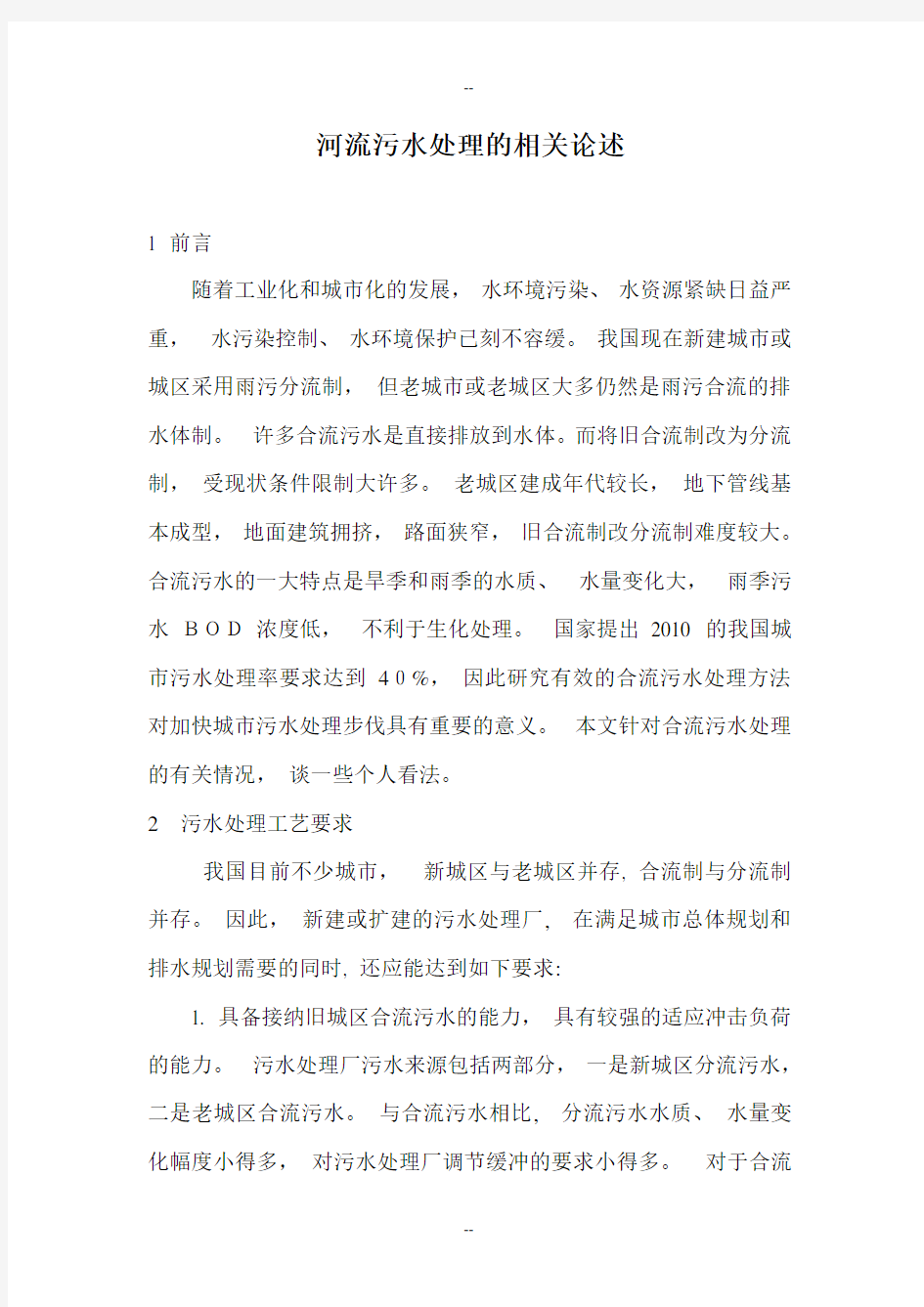污水处理英文翻译


河流污水处理的相关论述
1 前言
随着工业化和城市化的发展,水环境污染、水资源紧缺日益严重,水污染控制、水环境保护已刻不容缓。我国现在新建城市或城区采用雨污分流制,但老城市或老城区大多仍然是雨污合流的排水体制。许多合流污水是直接排放到水体。而将旧合流制改为分流制,受现状条件限制大许多。老城区建成年代较长,地下管线基本成型,地面建筑拥挤,路面狭窄,旧合流制改分流制难度较大。合流污水的一大特点是旱季和雨季的水质、水量变化大,雨季污水BOD浓度低,不利于生化处理。国家提出2010 的我国城市污水处理率要求达到40%,因此研究有效的合流污水处理方法对加快城市污水处理步伐具有重要的意义。本文针对合流污水处理的有关情况,谈一些个人看法。
2污水处理工艺要求
我国目前不少城市,新城区与老城区并存, 合流制与分流制并存。因此,新建或扩建的污水处理厂,在满足城市总体规划和排水规划需要的同时, 还应能达到如下要求:
1. 具备接纳旧城区合流污水的能力,具有较强的适应冲击负荷的能力。污水处理厂污水来源包括两部分,一是新城区分流污水,二是老城区合流污水。与合流污水相比,分流污水水质、水量变化幅度小得多,对污水处理厂调节缓冲的要求小得多。对于合流
污水,降雨前期因雨水冲刷街区,合流污水较脏, 但水量相对较小, 降雨后期水量较大,但污水中有机物浓度相对较小。因此, 降雨前期合流污水,可考虑与分流污水一起经预处理后进入污水处理构筑物。降雨后期合流污水,除一部分与分流污水一起经污水预处理构筑物进入污水处理构筑物外, 另一部分可考虑通过雨污溢流构筑物进入雨污溢流沉定池后排入附近水体。为了对进入污水处理构筑物的合流污水高峰流量、水质波动进行缓冲调节,污水处理构筑物前端可设缓冲调节池以均衡水质、储存水量。
2. 具有可靠的BOD、COD、SS 去除功能及氮磷去除功能, 保证最终出水水质稳定。通常情况下, 城市污水中难降解有机物较少,BOD、COD 去除比较容易实现,而氮磷去除则较复杂。我国现行的污水排放标准对污水处理厂出水氮磷指标有严格的要求,故城市污水处理都必须达到氮磷的有效去除。在现行城市污水脱氮除磷工艺中,A2/0采用较为广泛。针对A2/0工艺存在的问题目前出现了许多改进工艺,每种工艺又都存在各自的特点和局限。由于合流污水引起的水质、水量波动较大,对污水厂各处理单元产生冲击,为了适应受纳水体的要求, 为使BOD、COD 等指标进一步降低,进一步去除污水中的细菌及氮、磷等植物性营养物质,在污水厂与受纳水体之间可设氧化塘。
3.具有灵活多变的运行方式,可根据收集的污水量、进水水质以及季节变化调整运行方式。常规A2/0工艺,很难做到灵活方便地调整运行方式。但A2/0工艺从构成原理上讲, 是在曝
气段前加厌氧段和缺氧段。这一原理用于氧化沟技术, 便可形成各种适应不同水质、水量、季节变化的运行方式。污水厂可根据实际情况设两个以上的氧化沟,每个沟设一定数量的水力推进器,池底均匀分布微孔爆气器。通过调整氧化沟污水进水管阀门、曝气器的开及关的区域、内回流比大小、污泥回流比大小及水力推进器运行个数,便可形成串联、并联等若干种运行方式。每种运行方式具有各自区域大小不同的厌氧段、缺氮段、曝气段。当旱季污水量小则采用串联运行方式,雨季污水量大,则采用并联运行方式。夏季温度高,硝化反应速度快, 则采用具有较小曝气区域、较小硝化段的运行方式,相应反硝化区域增加、功能加强, 冬季情况则正好相反。如进水碳源浓度较低,则采取串联的、使后续反硝化段的碳源能得到补充的运行方式。
3工艺流程选择和特点说明
根据污水合流制与分流制并存的特点及处理后污水排放水体的要求: 来自新城区的分流污水,经格栅处理后进入后续污水处理构筑物; 来自老城区的合流污水平时直接进入污水处理系统。降雨时,前期的较脏、水量较小的合流污水, 与分流污水一起经格栅后进入后续污水处理构筑物。降雨后期的合流污水水量较大主要含泥砂,一部分经雨污溢流构筑物,在沉淀池作短暂停留, 去除部分泥砂后直接排放水体,另一部分则与分流污水一起经格栅后进入后续处理构筑物。格栅用以去除污水中的大块悬浮物、漂浮物等污物, 以消除大块污物对后续处理系统的不良影响。曝气沉砂池用以去除较
大砂粒及其他无机污染物颗粒, 以提高污泥活性有机组分含量、减轻对管道设备的磨损、减轻后续沉淀池负荷、改善系统运行条件。初沉池主要用以去除SS,在初沉池中,根据进水水质情况,可适时外加碳源和氨氮,以保证有足够量和适当比例的C、N、P来源,为后续生化反应正常运行创造条件。缓冲池主要作用是在合流污水高峰流量时均衡水质、储存水量。氧化沟是一种简易、高效、经济的城市污水处理工艺近几十年发展迅速。在流态上, 它既是完全混合式, 又具有推流式特征。由于沟渠溶解氧浓度的递减变化规律, 通过适当安排进水口、出水口、回流污泥入口位置,氧化沟可形成一个倒置A2/0工艺。根据硝化、反硝化、生物除磷及好氧活性污泥微生物的代谢特在缺氧段, 主要功能是脱氮,回流污泥中反硝化菌以原水中有机物为碳源,以来自好氧段的硝化液中的硝酸盐为电子受体, 将硝态氮NO-3-N 还原为气态氮N2。在厌氧段,主要功能是释磷,回流污泥中聚磷菌分解释放体内聚磷酸盐,同时摄入污水中的有机物,以PHB 及糖原等形式储存于细胞内。对于缺氧段与厌氧段的过渡过区域,既非严格的厌氧状态,而溶解氧浓度又低于缺氧段, 脱氮与释磷过程都将存在,但都不易取得竞争优势。在好氧段, 功能有三: 1、好氧活性污泥中微生物,使污水中有机物得到降解、去除,好氧微生物本身得以增殖, 活性污泥得以增长;2、在亚硝化菌和硝化菌作用下, 将污水中氨氮NH+4-N 氧化成硝态氮,主要为NO-3-N;3、聚磷菌体内PHB 氧化产生大量能量一部分用于从污水中过量吸收磷酸盐, 并以聚磷
的形式贮存于体内,一部分供给细菌合成和维持生命。与A2/0工艺相比,前置缺氧段不仅可优先从污水中获得碳源, 强化反硝化过程。同时,因先经历反硝化过程,消除了硝酸盐的大量存在对聚磷菌厌氧释磷过程的不利影响。通过对曝气器的控制, 沟渠内可形成区域大小适宜的缺氧段、厌氧段、曝气段, 在去除BOD的同时进行生物脱氮除磷, 能取得较好的氮磷去除效果。特别是能够通过对曝气区域大小和进出水管阀门的控制,形成灵活多变的运行方式,适应污水水量、水质、季节性的变化, 具有广阔的发展应用前景。当水质波动幅度不大时,通过前述的预处理、生物处理后的污水,一般能排放水体,但由于各种不确定偶发因素的影响, 这样考虑处理水排放存在不小风险。当水质、水量大幅波动时这种情况更为突出。由于水污染、生态破坏的严峻形势,城市污水处理厂必须从技术上严格把关,从工艺上确保处理水安全排放水体。若在生物处理工艺之后设置熟化塘,不仅可在污水处理厂和受纳水体之间起缓冲作用, 还能通过藻类-动物性浮游生物-鱼类等食物链和生态系统,使BOD、COD指标、细菌及氮磷等植物性营养物浓度进一步降低, 具有良好稳定的处理效果。特别是在熟化塘系统中, 通过塘内生态系中多条食物链的物质迁移、转化和能量逐级传递、转化, 在去除污染的同时, 以水产资源形式达到物质、能量的回收,将污水处理与利用相结合, 实现污水资源化。
4 结语
1. 合流制污水水质、水量波动幅度大, 技术工艺必须满足缓和冲
击负荷的要求,设置缓冲池均衡水质、储存水量比较适宜。
2. 通过多个氧化沟构成若干个串、并联运行方式,在适应进水水质、水量、季节性变化方面能够发挥重要作用。
3. 通过安排适当的进出水口位置、回流污泥入口位置,氧化沟可形式一个倒置A2/0 工艺, 在去除BOD 的同时,能取得较好的氮磷去除效果
4. 熟化塘的应用,为处理水安全排放水体,能够提供可靠的技术保证。熟化塘投资省、运行费用低、管理维护方面、污水处理与利用相结合, 在防治水污染、保护水环境及生态环境综合治理方面具有明显优势。如果美化熟化塘表观, 设置喷泉等设施,形成供人们休闲、游乐的人工景点, 协调城市建设中土地资源的合理配置,那么熟化塘占地面积较大这一不足就不会成为突出的问题。
?
Combined sewage treatment related d
iscussion
1 Preface
With the industrializationandurbanization development, waterpollution,worsening water shortage, waterpollutioncontrol, environmental protection h as urgentneedof water.China isnow adopting anew cityor urban stormwater sewagediversionsyst
em,but the old city or theoldcityis stillmostly combined sewage stormwater drainage system,a numberof combinedsewage is directly discharged into the water body. The confluence of the old system toa triagesystem, the status quoconditions, and many of theold citybuilt during the long, undergroundpipeline basic shape, the groundconstruction crowded,narrowroads, the old Combined triage systemmore difficult to change.Combined sewage isa major featureofthe water qualityof the dry andwet seasons,water changes,low BOD effluent concentrationduring t herainy season isnotconducivetobiochemical trea tment.Countries, 2010 China's urban sewage treatme nt rateof40 percent required, and therefore the studyof theconvergence of effective methods ofsewage treatment, sewage treatment to accelerate the pace of the cityisofgreat significance.In this paper,the convergence of thesewage treatmentsituation,s ome personal views.
2 Requirements of the sewage treatment process
Many cities inChina,the new city with thecoexistenceof theold city,Combined with thest
reaming system co-exist. Therefore, new orexpa nded sewagetreatment plantto meet theoverall urban planning and drainageplanningrequirements should be able tomeet the following requirement s:
(1) Have to accept merging the old citysewage capabilities, a strongabilityto adapt totheimpac tload. Source of thesewage treatmentplant efflue nt is composed oftwo parts: First, the new urban s ewagediversion; Second,mergingthe old city sew age. Compared withthe combined sewage,sewagediversion of water quality, water, a much smaller range ofsewage treatment plants requiremuch less adjustmentbuffer. Theconfluenceofsewageand rain red rain due topre-rinse blocks, mergingmore dirty water,but water is relatively small;rainwater,the larger the latter,but the concentration oforganic compounds inwateris relatively small.Therefore,pre-confluencerain water,couldbe considered together with the diversionof sewage by pre-treated sewageinto thestr ucture. Combined sewagelaterainfall,withthe exceptionof part ofthesewage, together withthe
diversion ofsewageby pre-treatment structures intothe sewagetreatment structures,andthe other partto consider theadoption of stormwater pollution entering the storm sewage overflowstructuresShen overflowpool setintothe nearby water bodyafter.Inorder to enter the structureof thecombined sewageeffluent peak flow,water quality buffer fluctuations conditioning, sewage treatment structures regulatingthe front -endbuffer pool can be installed in order to balance water quality, storageof water.
(2) ReliableBOD, COD, SS removal ofnitrogenand phosphorus removal function and features to ensure the stabilityof the finaleffluent quality. Under normalci rcumstances,urban sewage in less refractoryorganicmatter,BOD, COD removal iseasier toachieve, rather than thecomplexity of nitrogen and phosphorus remov al.The currenteffluent standards forsewagetreatment plant effluent nitrogen and phosphorus indicators have strict requirements, itmustbe of urbansewage treatment toachievethe effective removal of nitro gen andphosphorus.Under the existingurban s ewage nitrogen and phosphorus removal process, A2 / 0
used morewidely. For theA2/0 process problems, the present situationof a number of improvementsin technology,technology also existsfor each of thecha racteristicsand limitations of each. As aresult of merging the water qualitycaused by sewage, water, volatile,wast ewater treatment plant on theimpact of the processing units,in order to adapttothe receiving water requirements,inordertoBOD,COD and otherindicators of a furtherdrop low,furtherremoval of se wage bacteriaand nitrogen, phosphorus and other plant nutrients in thewastewater treatment plant and receiving water can be established betweenthe oxidationpond.
(3) Withflexible operation mode, accordingto the quantity of sewage collection, water quality and seasonal variation of the adjustment operation. Conventional A2/ 0 process,it is difficult todo adjust the flexible operationmode. However,A2 /0 process from theprinciple constitutes asense,beforethe paragraph in the aeration and anoxic plus anaerobic paragraph. This principle fortheoxidation ditch technology can be adapted to the formation of a variety o
fdifferent water quality, quantity,seasonal changesintheoperating mode.Wastewater treatmentplan tcan be established according tothe actual situation of the oxidation ditch morethantwo,each for a certain amount of ditch waterpropeller,bottom uniform microporous gasexplosion device.
3 Selection and characteristics of that process
Oxidation ditch is a simple,efficient andeconomicalmunicipalwastewatertreatment technology, has developed rapidlyinrecentdecades.In the flo wpattern, itis completely mixed,but also has push-flow characteristics. As aresultofthe decreasingconcentration ofdissolved oxygen ditchesc hanges andappropriate arrangements throughthe inlet, outlet, backtothe entrance ofthe location o fthesludge, oxidation ditch can be inverted to forma A2/ 0process:
Combined sewage system inaccordance with the characteristics of both a triage system, and treatedwater discharge requirements.
Grille to remove the effluentsuspendedsolids inthelarge,floating debris suchas dirt, to
remove largepieces of dirt on the follow-upto theadverseeffects of treatment systems.Aerated gritchamberto remove large sand particles and other i norganicpollutantsinorder toimproveActiveorganic component content in the sludge,reducingwearand tear on the plumbing, the follow-upsedimentation tanks toreduce load and improve the system operating conditions.Primarysedimentationtank for removalofthe main SS, Shen pool in thebeginning, according to theinfluent water quality can be a timelyad dition to carbon and nitrogen in ordertoensureadequate and proper proportionof C,N, P sources,inorde rto follow-upbiological and chemicalresponseto c reate the conditionsfor normal operation. The main roleof a buffer poolof sewage in the combined balan ceofthewaterquality peak flow, storageofwater.
And A2 /0 process, the pre-hypoxic paragraph priorit ynotonly to obtaincarbon from the wastewater,and strengthen the process of denitrification.At t hesame time,by firstgoing through the process of denitrification, nitrate eliminated theexistence of a larg
